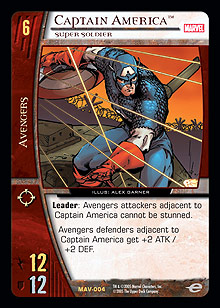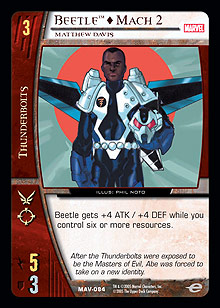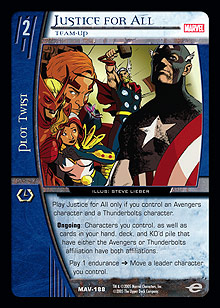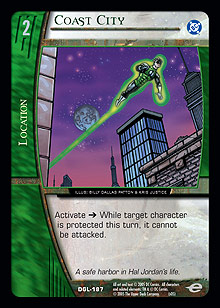
The American Dream
A few months ago, Mark MacSween sent me an email discussing the possibility of breaking heroic comic icons. This notion particularly intrigued me, as it opened the potential for building a more flavor-oriented deck.
One aspect of Vs. System that I have always enjoyed is that the abilities of certain characters emulate their comic personas. For example, Superman has always embodied the ultimate guardian. Though he is one of the most powerful beings in the universe, he has always used his incredible powers to protect others. Accordingly, his various versions in Vs. System usually have some sort of defensive characteristic (such as Superman, Clark Kent redirecting attacks toward himself and Superman, Kal-El providing reinforcement and invulnerability to those he is protecting).
Spider-Man, on the other hand, is not the powerful protector that Superman is. While still a defender of innocents, he uses his agility and athleticism to trip up his adversaries. This trait is apparent in Spider-Man, The Spectacular Spider-Man and Spider-Man, The Amazing Spider-Man, both of whom are premier character cards for shutting down your opponents’ attacks.
For this (belated) Independence Day, I wanted to look at Captain America—particularly, Captain America, Super Soldier. Since the release of the Avengers set, the leader mechanic has been somewhat underplayed. However, from a flavor perspective, the leader mechanic is quite appropriate for Captain America. On his own, Captain America is not really all that imposing. Sure, he can take on your ordinary hoods and thugs without too much difficulty. But put Cap up against a baddie like Magneto, and he’s not quite in the same league.
What Captain America does excel at, though, is improving the coordination and skills of those that he works with. He is a clever and skilled tactician, so it only makes sense that other characters become better when he’s nearby. This is, in effect, what Captain America, Super Soldier is all about.
In honor of our super soldiers serving abroad, we’re going to put Vs. System’s resident Super Soldier in action. Captain America is going to show players far and wide what it truly means to be a leader and an American!
The Build
 Our feature card is only going to receive three spots in today’s deck. This primarily has to do with the fact that Captain America is a 6-drop, so we have several turns in which to draw into him or a way to search for him. In all truthfulness, we could probably get away with playing only two copies, but Captain America’s leader status can come in handy for some of our discard effects, too.
Our feature card is only going to receive three spots in today’s deck. This primarily has to do with the fact that Captain America is a 6-drop, so we have several turns in which to draw into him or a way to search for him. In all truthfulness, we could probably get away with playing only two copies, but Captain America’s leader status can come in handy for some of our discard effects, too.
At 1, we’re going to play four copies of Beast, Furry Blue Scientist. Unlike his role in reservist builds in the past, Beast actually has a purpose beyond that of going into our resource row. We will be exploring the leader mechanic in this deck, so we’ll be using two teams from the Vs. System that are heavy in leader characters: the Avengers and Thunderbolts. Moreover, the Team-Up card for these two teams, Justice for All, is phenomenal for making the most of our leader characters. So Beast is a great choice for us to get our Team-Up into play early.
Of course, what would any Avengers deck be without Rick Jones? He meets two of my primary conditions for truly great 1-drops: an alternate recruit cost and a relevant effect. For the price of a simple character card discard, Rick Jones becomes a reusable source of reinforcement for our characters. He is an amazing card and certainly worth inclusion in our build.
At 2, we begin the team splitting. For the Thunderbolts, we have our primary drop in the form of Erik Josten à Atlas, Kosmos Convict]. As far as 2-drops go, Atlas starts out below the norm. However, he starts to become more and more impressive as time passes, gaining a +1 ATK / +1 DEF counter at the beginning of turns 3 and 4. If your opponent doesn’t have a way to keep Atlas in check, then he gets truly huge in the later turns, gaining two +1 ATK / +1 DEF counters at the start of each turn. You thought Shape and Melissa Gold à Songbird, Sonic Carapace were big? Just wait until your opponent is staring down your 10 ATK / 10 DEF Atlas!
Our backup drops come from the Avengers. First, we have Wasp. She is a decent 2-drop at 2 ATK / 3 DEF with flight and range. In addition, she has an effect that will occasionally be relevant if we feel the need to team attack with a couple of adjacent attackers. Finally, she is a leader, so she supports the deck theme nicely. Our other 2-drop can also work as a backup 3-drop. Falcon gets very little play outside of Avengers Draft. Yet he has the potential to become the most potent of the Avengers 2-drops. He starts out as a mediocre 2 ATK / 2 DEF with flight. However, he jumps to a 4 ATK / 4 DEF when positioned adjacent to a leader. Any 2-drop that can take down an average 3-drop is a decent play. And considering that Falcon has a boost effect that facilitates getting leader characters into play, he’s an easy choice for our deck.
 At 3, we’re going to play four copies of Beetle à Mach 2. This version of Beetle is somewhat bittersweet for us. On the downside, Mach 2 doesn’t have a relevant early-game effect, and his 3 DEF means that he can be taken down by many 2-drops. However, if we are able to weather the early attacks, then our 3-drop leaps in size to that of a 5-drop on turn 6. Such a powerful effect forces our opponent to take an aggressive slant against our deck or suffer the consequences of getting thoroughly beaten in the later turns.
At 3, we’re going to play four copies of Beetle à Mach 2. This version of Beetle is somewhat bittersweet for us. On the downside, Mach 2 doesn’t have a relevant early-game effect, and his 3 DEF means that he can be taken down by many 2-drops. However, if we are able to weather the early attacks, then our 3-drop leaps in size to that of a 5-drop on turn 6. Such a powerful effect forces our opponent to take an aggressive slant against our deck or suffer the consequences of getting thoroughly beaten in the later turns.
You may have noticed a trend with this deck to play characters that can contend with higher-cost characters in later turns. Our primary drop at 4 also fits this trend. He is the mighty Iron Man à Cobalt Man. While Cobalt Man has a tremendous set of recruit restrictions, he is certainly well worth playing. Not only does he boast scale-tipping 11 ATK / 7 DEF as a 4-drop, but he also gains invulnerability when he attacks. Cobalt Man is only capable of being played in one particular deck, but that happens to be the deck we’re playing . . . so we’re going to play him!
Of course, we may run into situations where we can’t recruit Cobalt Man due to his loyalty restrictions. Thus, we’ll also include a copy of Iron Man, Tony Stark. While not as formidable as his Thunderbolt persona, Iron Man is still a respectable 7 ATK / 7 DEF 4-drop with flight and range. He also boosts the stats of those around him and gives them flight and range, as well. Finally, those unusable copies of Iron Man à Cobalt Man become nifty power-ups for this version of Iron Man.
At 5, we have one of the best leader cards in the game in Hawkeye, Leader by Example. Hawkeye boasts an enormous 11 ATK, which is enough to stun almost every 4- and 5-drop in the game naturally (and quite a few 6-drops, as well!). But his leader ability is what is key here. This is where our large low drops will really start to pay off for us, as our characters will be able to swing up the curve without stunning back. Barring any significant defensive tricks, Cobalt Man will be able to take out any 5-drop our opponent plays, and Mach 2 and Atlas will usually be more than a match for any opposing 4-drop. This leaves Hawkeye free to deliver a beating on an opposing character much smaller than himself. Needless to say, Hawkeye can be a source of substantial board advantage.
Of course, Captain America is our 6-drop. He makes our other characters more than amazing both while attacking and defending.
 At 7, we have a couple of options. If we find ourselves with limited board presence, then Hulk, Gamma Rage is our man. Hulk is very particular about who he will play with. But we do have the tools in this deck to make him work. Coming in at a massive 17 ATK / 17 DEF, Hulk is bigger than all but a few 7-drops and a decent match for many 8-drops. And if we still have endurance to spare, Hulk will become even more of a pain for our opponents, as we can pay 7 endurance and exhaust Hulk rather than stun him . . . and he gets bigger! Combine all of that with the added bonus of Captain America, giving Hulk +2 ATK / +2 DEF while defending, and we have a nigh-impenetrable wall through which most players will not dare attack.
At 7, we have a couple of options. If we find ourselves with limited board presence, then Hulk, Gamma Rage is our man. Hulk is very particular about who he will play with. But we do have the tools in this deck to make him work. Coming in at a massive 17 ATK / 17 DEF, Hulk is bigger than all but a few 7-drops and a decent match for many 8-drops. And if we still have endurance to spare, Hulk will become even more of a pain for our opponents, as we can pay 7 endurance and exhaust Hulk rather than stun him . . . and he gets bigger! Combine all of that with the added bonus of Captain America, giving Hulk +2 ATK / +2 DEF while defending, and we have a nigh-impenetrable wall through which most players will not dare attack.
If we find ourselves with a substantial board presence on turn 7, then Beetle à Mach 4 should probably be our play. Granted, uniqueness would force us to KO Mach 2 if we bring Mach 4 into play, but Mach 4 would still be a powerful play because he can allow Atlas, Falcon, and Cobalt Man to swing way up the curve! Our characters will usually be big enough to swing one or two spots up the curve before Mach 4 ever sees play, but Mach 4’s +4 ATK / +4 DEF bonus makes it possible for our characters to jump another one to two spots up. Imagine Atlas and Cobalt Man taking down your opponents’ 6- and 7-drops. It is not only possible but very likely if Mach 4 sees play.
At 8, we have the perfect finisher in Thor, God of Thunder. Already weighing in at 20 ATK / 20 DEF, Thor also provides a huge boost to adjacent characters, giving them additional ATK equal to their cost. Mogo, The Living Planet may be big, but our 23 ATK Mach 4 is more than a match for him. Can Onslaught survive the onslaught when we send a 24 ATK Hulk after him? And imagine the sheer look of amazement when we send a 19 ATK Cobalt Man (aided by both Mach 4 and Thor) after Apocalypse! Barring a catastrophe, Thor will usually signal the end for our opponents.
 Looking at plot twists, we’ll start with our Team-Up, Justice for All. I really can’t stress how powerful this is in this deck. One typical problem with playing multiple leader characters is that their effectiveness is limited to how characters can be formed. Justice for All alleviates this problem to a great extent by making your leaders capable of moving to where they are needed. For example, imagine that we have Captain America, Hulk, and Thor all in play. Our natural formation would be to have Hulk protecting Captain America and Thor flanking Hulk in the front row. This gives Hulk the benefit of both Captain America and Thor’s effect. However, this formation does not allow Captain America to benefit from Thor’s effect, or vice-versa. But with Justice for All in play, we can move either leader as necessary to allow them to confer their benefits to one another. On our attack, we can swing with Hulk, then move either of our leaders adjacent to the other to activate their leader abilities. On defense, Justice for All provides for some clever combos after attacks have become legal, as well as a variety of reinforcement options. It is the card that holds our deck together.
Looking at plot twists, we’ll start with our Team-Up, Justice for All. I really can’t stress how powerful this is in this deck. One typical problem with playing multiple leader characters is that their effectiveness is limited to how characters can be formed. Justice for All alleviates this problem to a great extent by making your leaders capable of moving to where they are needed. For example, imagine that we have Captain America, Hulk, and Thor all in play. Our natural formation would be to have Hulk protecting Captain America and Thor flanking Hulk in the front row. This gives Hulk the benefit of both Captain America and Thor’s effect. However, this formation does not allow Captain America to benefit from Thor’s effect, or vice-versa. But with Justice for All in play, we can move either leader as necessary to allow them to confer their benefits to one another. On our attack, we can swing with Hulk, then move either of our leaders adjacent to the other to activate their leader abilities. On defense, Justice for All provides for some clever combos after attacks have become legal, as well as a variety of reinforcement options. It is the card that holds our deck together.
Another card that we may well find use for is New Identity. While our deck will not contain a standard set of ATK or DEF pumps, it will contain firepower of different varieties that make it competitive. New Identity is a stellar example of this, as it provides a +1 ATK / +1 DEF counter to one of our characters at the end of each turn. This is obviously going to have some utility for us, even in small amounts, as an extra +1 ATK / +1 DEF can be the difference between stunning and not stunning. However, New Identity can become absolutely absurd in multiples or if we get it into play early enough on a character like Atlas. Just imagine going into turn 5 with two copies of New Identity on Atlas from turn 2—that’s a total of ten counters! Our 2-drop would be 12 ATK / 12 DEF!
Obviously, we should think about playing character searchers. We’ll want to play four copies each of Avengers Assemble! and Enemy of My Enemy. Avengers Assemble! continues to feed into our leader theme, giving us an effective search card and a small stat boost that supplements cards like Atlas and New Identity quite nicely. While we aren’t playing a lot of leader characters, we should have enough to support Avengers Assemble! when we need to. Regarding Enemy of My Enemy . . . yeah, it’s a great searcher for any Team-Up deck. You probably know that by now!
Our final plot twist is going to stray a bit from the beaten path. As we discussed earlier, the leader mechanic works by supporting adjacent characters. Obviously, then, we want to keep those characters around if possible. So, we’re going to play four copies of Revitalize. This card can be absolutely amazing in unison with the leader theme. Imagine that we have Hawkeye and Captain America in play, with Hawkeye protecting Cap. Our opponent already has to attack through a 13 ATK / 11 DEF Hawkeye to get at Captain America. Without any additional pump, this will be tough for most 4- and 5-drops to accomplish, and even most 6-drops will stun back when attacking into Hawkeye. Assuming that our opponent does get through Hawkeye, however, a timely Revitalize will ensure that he or she will have to go through the gauntlet again to get a shot at Cap. Even the most powerful decks will have a tough time breaking through that blockade.
 But I’m sure a few of you are wondering how I could be so brazen as to say that our opponents will have to attack through Hawkeye when they could simply fly over and attack Cap. The answer, friends, comes in the form of our first location, Coast City. Personally, I have never been a big fan of this card. But I do recognize its strength in a leader-based deck. Since the key to success with our leaders is to use them to boost other characters, we want to force our opponents to attack into our leader-boosted characters. With Coast City in play, this is exactly what will transpire. Our opponent may have characters with flight across the board, four copies of Flying Kick, and even a copy of Sewer System in play. But with a single copy of Coast City, our opponent has no choice but to attack into our 19 ATK / 19 DEF Hulk that is protecting Captain America. Good game!
But I’m sure a few of you are wondering how I could be so brazen as to say that our opponents will have to attack through Hawkeye when they could simply fly over and attack Cap. The answer, friends, comes in the form of our first location, Coast City. Personally, I have never been a big fan of this card. But I do recognize its strength in a leader-based deck. Since the key to success with our leaders is to use them to boost other characters, we want to force our opponents to attack into our leader-boosted characters. With Coast City in play, this is exactly what will transpire. Our opponent may have characters with flight across the board, four copies of Flying Kick, and even a copy of Sewer System in play. But with a single copy of Coast City, our opponent has no choice but to attack into our 19 ATK / 19 DEF Hulk that is protecting Captain America. Good game!
Finally, we need to put four copies of Slaughter Swamp in the deck. With only ten leader character cards, they will definitely be at premium for use with Avengers Assemble! and Hulk. Therefore, it only makes sense to have a source of recursion available to us so that a single leader can fill multiple functions. In addition, Slaughter Swamp can be randomly useful as a power-up in times of need. And we won’t have to worry about discarding late game character cards because we can fetch them back with our recursion location!
Cap and crew are a group of staunch defenders. It’s time to see what kind of power they bring to the board:
Justice for All (60 cards)
Characters (32)
4 Beast, Furry Blue Scientist
2 Rick Jones, A Hero’s Best Friend
4 Erik Josten à Atlas, Kosmos Convict
2 Falcon, Sam Wilson
2 Wasp, Janet Van Dyne-Pym
4 Beetle à Mach 2, Matthew Davis
4 Iron Man à Cobalt Man, Avenger in Disguise
1 Iron Man, Tony Stark
3 Hawkeye, Leader by Example
3 Captain America, Super Soldier
1 Hulk, Gamma Rage
1 Beetle à Mach 4, New Team Leader
1 Thor, God of Thunder
Plot Twists (20)
4 Avengers Assemble!
4 Enemy of My Enemy
4 Justice for All, Team-Up
4 New Identity
4 Revitalize
Locations (8)
4 Coast City
4 Slaughter Swamp
The mulligan should probably be for either Erik Josten à Atlas, Kosmos Convict or Beetle à Mach 2 so that you can cinch Iron Man à Cobalt Man for turn 4. While you could feasibly hold on to an early curve with other characters, it is much easier to focus on these two, as they are your only opportunity to get a Thunderbolts character into play before turn 4. The Avengers, on the other hand, have potential drops on turns 1, 2, and 3; more character searchers; and the ubiquitous Rick Jones (who can be recruited for free on turn 4 if you need the Avengers character in play).
Initiative is probably not much of an issue, as the deck can operate on either initiative. Against faster decks, you may want to go with odds to make the most of Iron Man à Cobalt Man and Hawkeye, Leader by Example on turn 5. Against slower decks, Hulk, Gamma Rage and Thor, Odinson can be quite a beating on turn 8, so evens might be preferable.
That’s all for this week. If you have any questions, thoughts, ideas, or comments that you wish to share with me, send me an email at BigSpooky1@hotmail.com.